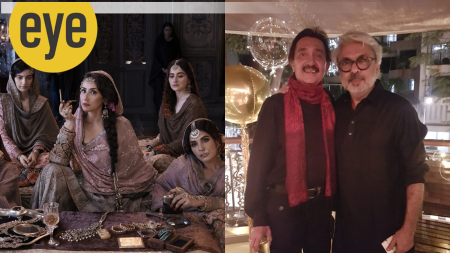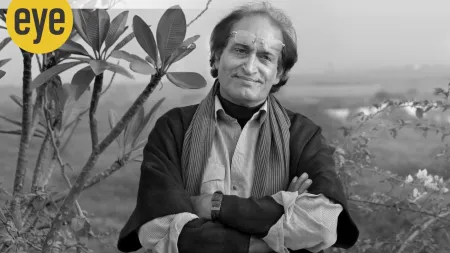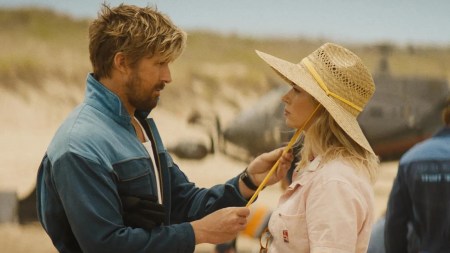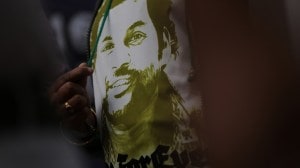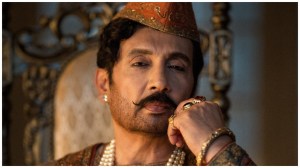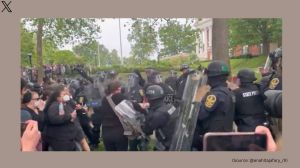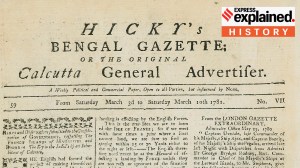- India
- International
Know Your City | Bangalore Palace: A Tudor castle in the middle of the city
At first sight, off Jayamahal Road, the palace's Tudor-style towers, crenellations, and fortifications, complete with creepers climbing the walls, would not seem out of place in an English countryside.
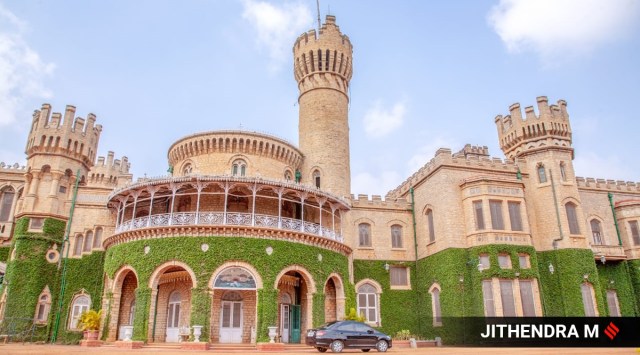 A view of the exterior of Bangalore Palace. (Express photo by Jithendra M)
A view of the exterior of Bangalore Palace. (Express photo by Jithendra M) To those who have visited the Amba Vilas Palace in Mysuru, the idea of the residence of the Wodeyar kings is something rooted deeply in their history as a dynasty that has survived six centuries. Their newer residence in Bengaluru, on the other hand, speaks more about their incarnation as modern rulers with international sensibilities at the head of a rapidly developing state in the closing years of the 19th century.
At first sight, off Jayamahal Road, the palace’s Tudor-style towers, crenellations, and fortifications, complete with creepers climbing the walls, would not seem out of place in an English countryside. While it is oft-repeated that the palace’s design was based on Windsor Castle, the connection is perhaps indirect at best. The features of the castle suggest inspiration from the Regency-era castles built by John Nash—some of which did indeed borrow design elements from Windsor Castle.
 A view of the exterior of Bangalore Palace. (Express photo by Jithendra M)
A view of the exterior of Bangalore Palace. (Express photo by Jithendra M)
The property itself was bought in 1873 from John Garret, an Englishman who was the founder of Central College as well as the author of an early Kannada translation of the Bhagavad Gita, shortly before the Wodeyars were restored to power by the Rendition Act of 1881. While the grounds themselves have been the subject of considerable legal disputes between the Government and the Wodeyar family, they have nevertheless been host to several events over the years—notably Eddfest, a music festival in 2007 headlined by the heavy metal band Iron Maiden drawing nearly 40,000 visitors.
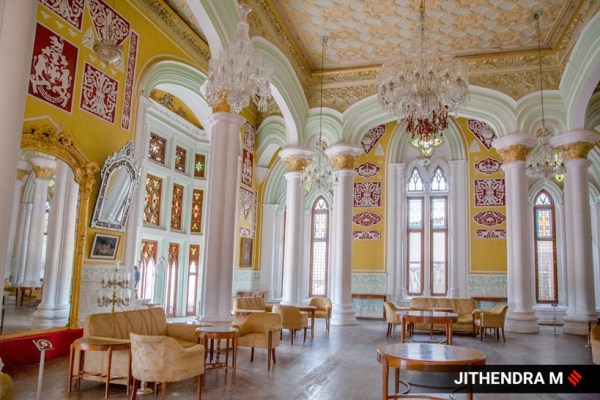 A view of the interior of Bangalore Palace. (Express photo by Jithendra M)
A view of the interior of Bangalore Palace. (Express photo by Jithendra M)
In the early days, the then Lalbagh superintendent John Cameron was said to have had a hand in the layout of the palace gardens, while the royal family later engaged the services of famed German botanist G H Krumbiegel to work on them as well.
 A view of the interior of Bangalore Palace. (Express photo by Jithendra M)
A view of the interior of Bangalore Palace. (Express photo by Jithendra M)
Visitors entering the palace first walk into a wide, open entrance hall that originally served as a ballroom. Apart from the elaborate carvings on the arches, visitors also notice a variation on the ancient gandaberunda sigil of the Mysore kings prominently displayed across many walls in the palace—that of the bird flanked by yalis, guardian beasts which are half-lion and half-elephant. This was confirmed as their coat of arms at the Grand Durbar of 1877, where Queen Victoria was officially confirmed as Empress of India.

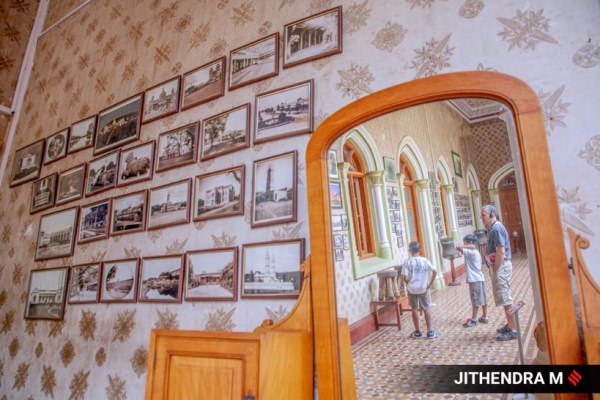 A view of the interior of Bangalore Palace. (Express photo by Jithendra M)
A view of the interior of Bangalore Palace. (Express photo by Jithendra M)
Slightly further ahead, one of Bengaluru’s first elevators is located within a cabinet next to a taxidermied head of an elephant, shot by Jayachamarajendra Wodeyar. Stools made of animal parts may be seen in other parts of the palace, which is somewhat ironic as Jayachamarajendra would later become known as an ardent conservationist.
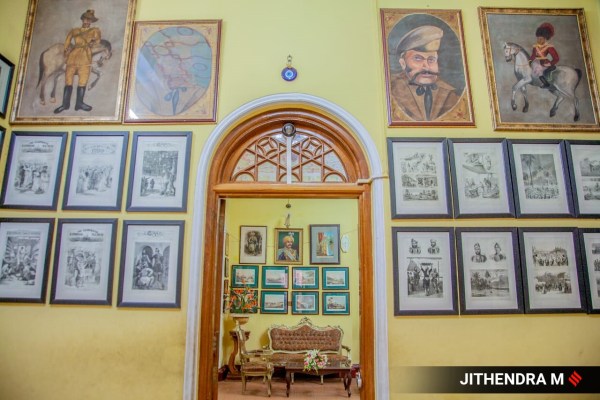 A view of the interior of Bangalore Palace. (Express photo by Jithendra M)
A view of the interior of Bangalore Palace. (Express photo by Jithendra M)
Throughout the palace, visitors can see a vast number of paintings, both original and reproduced, across a wide spectrum of Indian and Western styles. A statue commemorates N Venkataswamy Raju, a daroga of the palace gardens who served in the Second Anglo-Afghan War. Up a nearby rosewood staircase flanked by German sculptures, visitors can reach the viewing platform for the Durbar Hall, originally meant for the women of the royal family. An immense gilt-edged Belgian mirror also catches the eye, but a nearby display indicates a renovation that never materialised would have replaced it with an Art Deco-style mirror reaching almost to the ceiling, all arranged by the famed Kolkata-based firm Lazarus and Co.
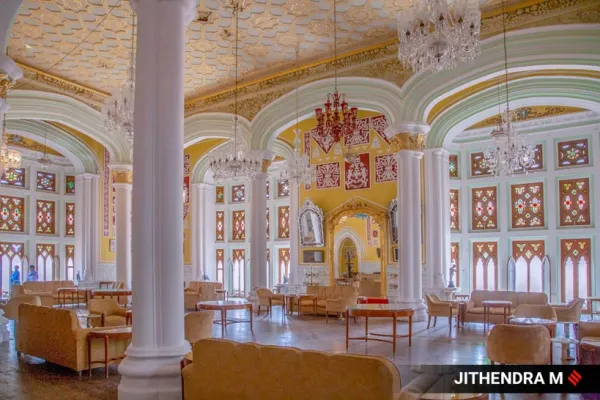 A view of the interior of Bangalore Palace. (Express photo by Jithendra M)
A view of the interior of Bangalore Palace. (Express photo by Jithendra M)
Further into the palace, a pair of twin courtyards would not have been out of place in Moorish Spain. One of these courtyards bears a pair of magnificent pieces of Spanish ceramic art, a bench, and a fountain said to have been fashioned by the foremost craftsmen of Seville. These were gifted after a visit by the exiled King Alfonso XIII, who fled Spain in the wake of rising Republican sentiment. It is said that the courtyard reminded Alfonso of those of Andalusia.
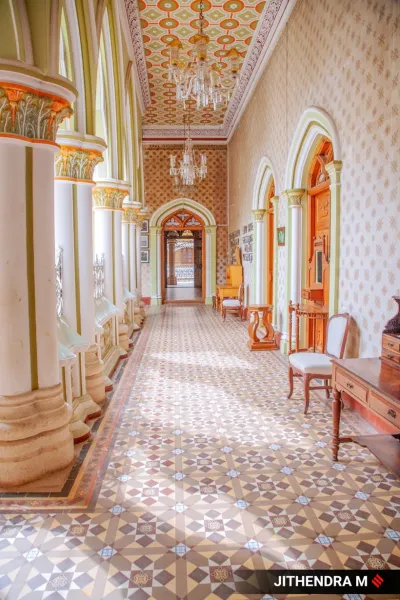 A view of the interior of Bangalore Palace. (Express photo by Jithendra M)
A view of the interior of Bangalore Palace. (Express photo by Jithendra M)
Other sights in the palace include many photographs of the more recent members of the royal family in formal and informal settings. The office of the late king Sreekantadatta Wodeyar has also been preserved, although direct entry is barred.
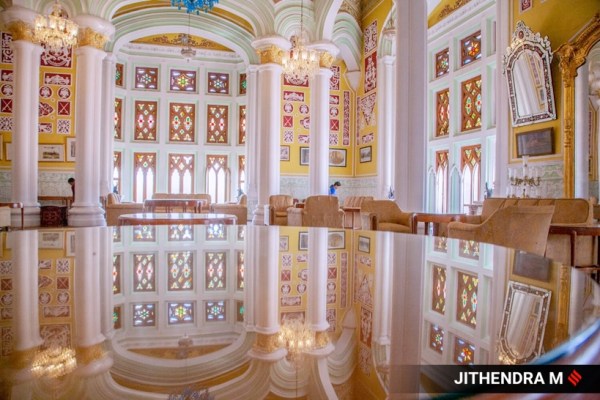 A view of the interior of Bangalore Palace. (Express photo by Jithendra M)
A view of the interior of Bangalore Palace. (Express photo by Jithendra M)
Entry to the palace is open on all days from 10 am to 5 pm, at a price of Rs 240 per ticket. An audio guide with headphones is also available, conditional upon a refundable deposit of Rs 2,000 or photo ID.
May 05: Latest News
- 01
- 02
- 03
- 04
- 05


